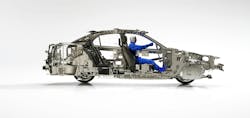Amberson: Are We Being Honest About Auto Repair Safety?
I was recently struck by a recent news report on how aggressively government entities are overseeing, regulating, and managing air travel safety issues. The topic receives a lot of news media coverage. My first reaction was to think, “Why are the safety issues over people in airplanes treated with so much more concern than those traveling in automobiles?”
Over the course of decades, the airline industry has gone through significant analysis and change to improve its safety. The Federal Aviation Agency (FAA) was formed in 1958. In 1967, the Department of Transportation was created, and the FAA fell under their jurisdiction, and the name changed to the Federal Aviation Administration (FAA). Today, their authority even extends to controlling the rate of aircraft production, which is based on safety records.
At the Collision Industry Conference (CIC) in April in Seattle, there was a presentation from a Boeing representative on how aircraft are repaired. While changing technologies have driven our auto repair industry to be far more dependent upon vehicle manufacturer repair procedures, we pale in comparison to the aircraft industry in terms of structured procedures and verifications . Over the decades, the aircraft industry’s safety record has improved immensely, even to the point some years where there were no fatalities from commercial air travel --and fatalities from private air travel are very few. The number of fatalities from auto collisions haven’t changed that much for many years. In the 1980s through 2007, American fatalities were in the 40-some thousand range. From 2008 through 2020, they were in the 30-some thousand range. And in 2021 and 2022, fatalities were back over 42,000. That’s far too many! Where is the outrage? We should all be appalled and strive for improvement.
I understand there are many factors and differences in speed and operation that create an imperfect comparison. But the point is, if the aircraft industry can go through self-evaluation and change, why can’t the auto industry do a better job of it?
While new advanced driving assistance systems (ADAS) and other safety features have certainly created measurable improvement, we have such a long way to go. And I understand the factors of human error causing accidents that will be difficult to eliminate. But shouldn’t we as a society be taking the “shotgun” approach of addressing all factors of relevance? That leads to considerations from our own collision repair industry.
Safety first, cost second
I pose to you that our traditional outlook (culture) and process is backward and too frequently rationalizes safety compromises. For all the decades I’ve been in this industry, we have traditionally created and estimated cost of repairs, typically with the primary focus on restoring the functionality of the vehicle in a way that we can “sell to” a customer or insurer, considering listing operations that we typically charged for and accepted. In many cases, especially within direct repair programs, trends for certain key performance indicators are considered. For example, if the shop has a poor “alternative parts usage score,” the estimator/blueprinter will be more likely to consider alternative parts. Sometimes the current economic situation on abundance of work is considered when making repair methodology decisions. Certain insurance or OEM relationships will influence decisions. When recently discussing rate adjustments due to inflation with an insurer, they asked me, “Aren’t you concerned over the numbers of total losses?” Some insurance representatives I interact with become zealots over keeping costs down and frequently talk about (almost a crusade) keeping premiums low.
This is where we should instead FIRST create a repair plan based on vehicle manufacturer repair procedures that prioritize safety. Cost considerations should be secondary. Upon establishing what a known good safe and proper repair plan is, we can then entertain the idea of lower cost alternatives. These should be considered with the primary objective of safety. For example, if we consider a salvage or aftermarket part, our first question should be whether or not it may compromise safety. With today’s vehicle’s increased sophistication and complexity, that becomes a much different question than in years past. The same would apply when considering repairing versus replacing a part. “Might it compromise safety?” All repair methodology decisions should first consider safety, then cost and other considerations after confirming that safety won’t be compromised.
Perhaps you are thinking that most repairs are safe and adequately consider safety. In many industry conferences and other meetings, I have many times heard repairers, insurers, and others testify to their company’s stance on safe and proper repairs. Yet I know from my decades of shop experience that is not always the case. Some of the most dramatic examples I’ve seen are the all-too-common examples of ’builders.” These are vehicles that were no doubt deemed to be a total loss and someone purchased and repaired the vehicle in a very substandard way, often obviously compromised and unsafe, and readily apparent to the trained eye. Often some unsuspecting consumer purchased the vehicle without understanding the compromised state of the vehicle and the tremendous cost in correcting it. Typically, they’ve insured the vehicle with no inspection or other concern from their insurer. Less dramatic, but just as guilty, are the many times that compromising repair methodology conversations take place with shop management/admin staff, technicians, and insurers. Often there is a wink and a nod, at least implied, that a lesser cost repair methodology will be ok. I know of some large repair businesses that think it is ok and normal to periodically have to buy back a repaired vehicle, implying that a percentage of compromised repairs is acceptable. These situations that I describe are exactly what I am saying needs to change if we are truly sincere about prioritizing safety.
About the Author
Darrell Amberson
Vice president of industry and OEM relations
Darrell Amberson is the vice president of industry and OEM relations at Quality Collision Group.
Previously, he was president of operations for LaMettry's Collision, a 10-location multi-shop operator in the Minneapolis area purchased by Quality Collision Group in November 2024. Amberson has more than 40 years of collision industry experience and served as chairman of the Collision Industry Conference for the 2021-2022 term, as well as interim chairman for the first two CIC meetings of 2024.

